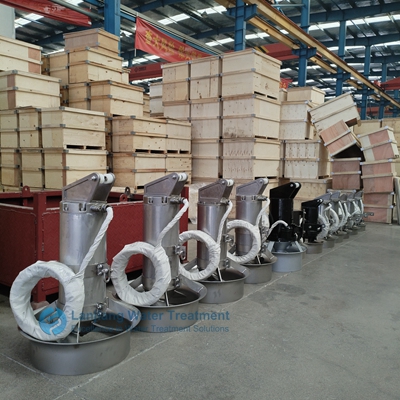The installation of a sewage mixer is a process that requires careful operation, and the following are some key installation considerations:
First, environmental conditions and location selection
1. Environmental conditions: The sewage mixer should be installed in a relatively open, well-ventilated, safe and reliable place to ensure the safety of the operator. At the same time, it should be avoided to install it in places susceptible to vibration or wear to prevent affecting the performance and life of the equipment.
2. Location selection: Select the appropriate installation location according to the characteristics of the sewage tank, sludge tank, biochemical tank and other specific places of use. The mixer must be fully submerged in water to ensure that it will not be interfered with by the external environment during operation.

Second, equipment specifications and selection
1. Equipment specifications: Before installation, the specifications and models of the sewage mixer should be carefully checked to ensure that they meet the design requirements and use needs.
2. Selection principle: The selection of submersible mixer should be based on factors such as volume, density, viscosity and mixing depth of the stirring liquid, to ensure that the mixer plays a full mixing function in the appropriate volume. The flow rate is an important reference indicator for selection, which should generally be guaranteed between 0.15\~0.3m/s.
Third, installation process and details
1. Arrange the cable: Arrange the cable during installation to ensure that the cable is not bent and twisted, and the end of the cable is not submerged in water to prevent cable damage or electric shock accidents.
2. Ensure verticality: When installing, ensure the verticality of the guide rod, and the upper and lower deviation shall not exceed 10mm, so that the mixer does not produce stuck or excessive friction on the guide rod, and can run freely up and down.
3. Lifting and positioning: When the mixer is installed, it should be ensured that the lifting point of the main engine lifting frame or lifting plate positioning hole is in a vertical line with the center of gravity of the mixer to ensure stability and safety during the lifting process.
4. Anti-corrosion treatment: In the sewage treatment industry, the combination of water and gas is the most corrosive, so it is necessary to perform anti-corrosion treatment on the installation system here, such as applying butter on the guide rod.
5. Impeller installation: impeller is the main component of stirring water pollutants, should ensure that its position is correct, firmly installed, rotation freely, to ensure that it can effectively stir water pollutants.
6. Angle adjustment: The mixer shall not rotate the Angle during operation, please adjust the Angle before running during installation. The mixer should be placed on the limit plate in the pre-adjusted position, or directly placed on the limit shelf at the bottom of the pool, so that the wire rope is not stressed.
Fourth, commissioning and trial operation
1. Manual turning: After the stirring device is installed, manual turning inspection should be carried out, and there should be no jamming, collision, and excessive resistance.
2. Trial run: water trial run not less than 1 hour, check whether the equipment has abnormal vibration and noise, motor and reducer have abnormal heating phenomenon.
Fifth, security and maintenance
1. Safety regulations: When operating the sewage mixer, the relevant operating procedures and safety regulations should be observed to ensure the safety of the operator.
2. Maintenance: In the process of use, attention should be paid to checking the operation of the motor, reducer, bearing and sealing parts of the equipment, timely cleaning the dust and dirt on the surface of the equipment, and regular equipment maintenance and repair.
To sum up, the installation of the sewage mixer involves many aspects and details, and it is necessary to operate in strict accordance with the installation instructions and operating procedures to ensure the normal operation and use of the equipment.
Post time:2024-07-18